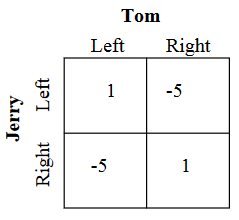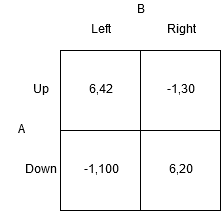There are several ethical theories that philosophers have come up with to describe how people should make decisions. Specifically, I will be discussing utilitarianism. There are two kinds of utilitarianism, act and rule. I will be using the definitions that the paper in the source uses. An act-utilitarian is “one who argues that each individual act should maximize the common good,” and a rule-utilitarian is “one who argues that utilitarian principles should be applied to the rules to which we appeal when making decisions.” The paper aims to use game theory to compare and contrast the decisions made by the two kinds of utilitarians.
To further explain the differences between the two types of utilitarians, the paper uses a simple game. The author makes assumptions similar to what we have seen in class, but I will quote them here:
“1)Both players must use the same decision procedure.
2)Both players are rational decision-makers.
3)Both players are able to accurately predict the outcome of a given combination of actions.
4)Both players are aware of the first three assumptions.”
The game the author uses involves two players driving towards each other, and there is enough space for them to drive by each other. Here is the payoff matrix the author provides:

Since the payoffs are the same for both players, the numbers are not repeated in each square. Using game theory, we can see that there are two pure-strategy Nash equilibria, both drivers veer to their left or their right, so they drive by each other, avoiding a collision. The author measures this outcome in terms of happiness received by each player.
Now we assume that both players are act-utilitarians, and they both know the other is an act-utilitarian per the rules of the game. Knowing this, both Tom and Jerry know the pure-strategy Nash equilibrium, but since they cannot communicate and based on their utilitarian principles since “act-utilitarianism does not suggest right over left or vice versa”, they both have no good reason to choose veering left over veering right, so the situation becomes one where each player is playing randomly. Therefore half the time they collide and half the time they pass by each other. The author concludes, and anyone would agree, that act-utilitarianism produces sub-optimal results here.
To contrast the two types of utilitarians, we now assume both players are rule-authoritarians, and both know the other is as well per the rules of the game. Again, both players know the pure-strategy Nash equilibria, but this time, either player would come up with a universal strategy for always winning this game, then make a decision based on the strategy they come up with. For this game, either player would come up with the strategy of “always veer left” or “always veer right”. This would be fine if both come to the same strategy, but since there are multiple pure-strategy Nash equilibria, we end up with the same result as with act-utilitarianism.
The author resolves this issue by saying that as a society we have created social contracts to resolve this kind of issue, namely which side of the road to drive on. For rule-authoritarians, they are bound to this rule, and so for the rule-utilitarian situation, there is never a crash. Act-utilitarians, however, are not bound to the rules, and can therefore still crash. The author considers that for this simple game, the act-utilitarians have no reason to not abide by the rule, but says that a more complex game could easily be devised where a situation could arise where they would. The author also concedes that this may not always be the case, as his rule-set limited the possibilities. If players were allowed to communicate, for example, then the outcomes would always be optimal.
I want to highlight a situation to differentiate utilitarianism from what we have used game theory for in class. Consider the following payoff matrix for some arbitrary game:

From the perspective we have taken in class, where both players want to optimize their own result, B has a dominant strategy of always playing left, then A would play Up, resulting in a pure-strategy Nash equilibrium of Up, Left. From the perspective of utilitarianism, where the aim is to optimize a collective result, a.k.a what brings the greatest good, B would still have a dominant strategy of playing Left, but A would play down.
When applying game theory to different perspectives or rule-sets, we can reach surprising or interesting results, and exploring what other ethical theories can result in using game theory can lead to a better understanding of decision making processes.
Source: https://core.ac.uk/download/pdf/46722288.pdf
